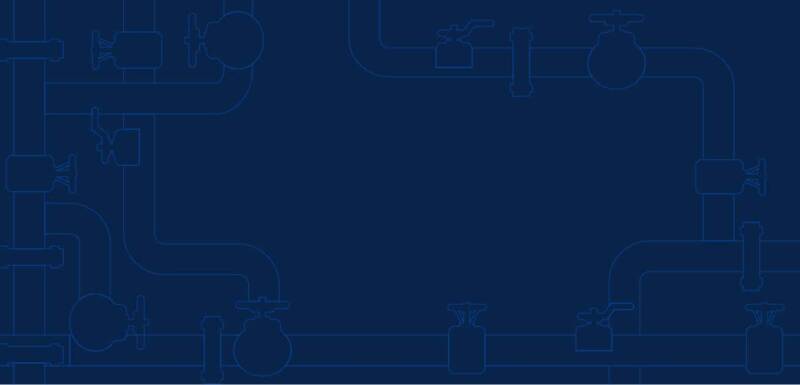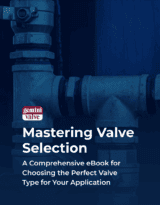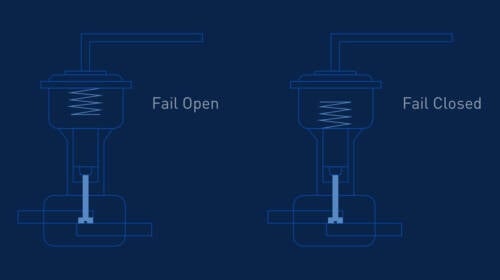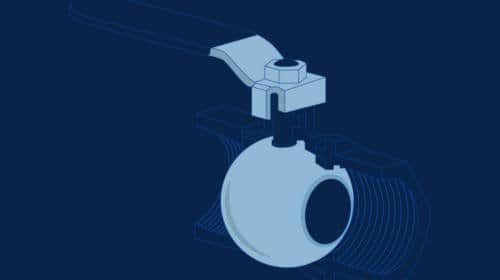Complete Guide to the Different Types of Valves

Complete Guide to the Different Types of Valves
There are many different types of valves, each serving a unique purpose depending on the specific application and system demands. Although most valves serve the same basic purpose, distinct characteristics and mechanisms allow some valve types to excel in specific applications.
Read on to learn more about valves and how they work, plus how to select the best valve type for your particular needs.
What Is a Valve & How Does It Work?
In the simplest terms, a valve is a device used to control the flow of a medium — liquid, gas or solid — through a piping system. Most commonly, valves are used to stop and start the flow of media. Some valves are also able to control the rate of flow, these are commonly referred to as control valves.
Because there are so many different uses for valves, they are available in a wide range of mechanical variations. Using the appropriate valve in a given scenario means your application will run smoothly and safely, accomplishing the intended goal most efficiently.
Though there are many different valve classifications, most valves fall within three categories: rotary, linear and self-actuated.
Rotary
Rotary valves utilize a rotating closure component to block flow within a piping system. Most often, this rotation is limited to 90 degrees, which is why rotary valves are also commonly referred to as quarter-turn valves. These types of valves are closed at 0 degrees and open at 90 degrees.
Some rotary valves can operate with a larger degree of rotation and include more than two positions. Common examples of rotary valve types are butterfly, plug and ball valves.
Linear
Linear valves use a flow obstructer — such as a disc, slat or diaphragm — that moves in a straight line to start, stop or adjust flow through a piping system. These valves can be separated into two distinct types: rising stem (multi-turn) and axial.
Multi-turn linear valves work particularly well in control applications and include globe valves, gate valves and needle valves. Axial valves, such as coaxial and angle seat valves, are fast-acting and used primarily in on/off process applications.
Compared to other categories of valves, linear motion valves tend to have longer cycle times than rotary valves.
Self-actuated
Unlike linear and rotary valves, self-actuated valves do not require direct input from the operator. Instead, they use the pressure within the process line to open or close a pressure control valve. This valve type is commonly used as a pressure relief valve and only opens once maximum allowable pressure is reached within the system. As a result of this mechanism, self-actuated valves are common safety requirements in certain applications.
Common self-actuated valves include relief valves, safety valves, check valves and steam traps.
Types of Quarter Turn Valves
Since quarter-turn valves allow for a wide range of motion with the turn of a handle, these valve types are commonly used in applications that prioritize quick and easy opening/closing over precision.
Ball Valves
Ball valves can be used in most applications where a fluid flow needs to be shut off. In fact, they are the most widely used process control valve. These rotary valves use ported spheres that swivel in the pipe stream, working to start or stop flow.
Since the valve’s port can be fitted precisely to match the pipe’s diameter, ball valves offer low head loss. Ball valves may be more expensive than other rotary valve options, but they offer better sealing than types such as butterfly valves.
Butterfly Valves
Butterfly valves work using a center-mounted, disc-shaped obstructer that sways in and out of the piping system’s flow. These quarter-turn valves are frequently used with larger pipe sizes and in wastewater plants, power plants and other process plants where shut-off, regulation, and isolation are called for.
Advantages of using butterfly valves include lower cost and smaller size. However, these common valve types are more vulnerable to leaks and head losses than ball valves and may not work as well against high-pressure flows.
Plug Valves
Plug valves are very similar to ball valves in their construction and function. However, instead of using a ball-shaped obstructer, plug valves obstruct or allow flow via a tapered cylinder that swings into or out of the flow stream. There are two main types of plug valves: lubricated and unlubricated.
This type of rotary valve is frequently used for shut-off and as a control valve for chemical processing industries, processing plants and wastewater treatment facilities. Plug valves may be favored for their lack of voids and cavities, and their ability to be adjusted for leaks that develop over the long term. As a result, these valves are often used in extreme service scenarios — think corrosive environments like oil refineries and chemical plants.
Types of Multi-Turn Valves
Commonly used in flow control applications, multi-turn valves work by cranking a handle to move an obstructer element into the flow path. This restricts flow within the piping system. Some types of multi-turn valves enable the flow to be released or blocked at variable speeds. These types of valves are commonly referred to as control valves.
Globe Valves
Globe valves work by using a globe-shaped disc to block flow when closed against a restriction orifice. These multi-turn valves are commonly used in on/off and throttling applications. Globe valves can seal both against or with fluid flow.
Two-way globe valves are recommended for precision, while 3-way globe valves are suitable for combining media from two inlet ports and sending the resulting mixture through an outlet port. Globe valves are frequently used in wastewater plants and food processing services. Although this valve type is available in many variations, the most prevalent is the Z-style valve.
Gate Valves
Gate valves are multi-turn valves commonly used to block flow streams and occasionally (and sometimes ineffectively) for throttling. This multi-turn valve type utilizes a plate-like barrier to block a flow stream.
Gate valves offer lower head losses when open compared to other valve types. Although their operation is comparable to globe valves, gate valves offer less flow restriction and regulation capabilities.
Needle Valves
Needle valves closely resemble globe valves aside from several key factors. First, they are smaller than globe valves and allow for more precise flow control within smaller systems. Additionally, they consist of a cone-shaped needle — as opposed to a disc-shaped plug — that moves into and out of an orifice to start and stop flow.
Needle valves offer a precise way of modifying fluid flow through a system. They can be used for on/on applications but may not be the best option in such instances, as they require many turns in order to close.
Types of On/Off Valves
Much as the name suggests, on/off valves are fast-acting devices that either enable unrestricted flow or block flow entirely. Though these types of valves do not allow for precise flow adjustment, they are useful in various applications where speed is essential, for example when used for situations that require emergency shut-off.
Solenoid valves
Solenoid valves use a linear sliding obstructer to open or shut the valve or redirect the flow from one outlet to another. These valve types are available in many different sizes, from as small as one millimeter to as large as 100 millimeters. Furthermore, they can be composed of various materials such as cast iron, stainless steel, aluminum, plastic and brass.
Solenoid valves are commonly used in emergency shut-off service applications and high-pressure systems. They can also handle a wide range of temperatures, with some models able to handle temperatures as extreme as -418° F to 1472° F, making solenoid valves a popular choice for cryogenic processes.
Coaxial valves
A coaxial valve is a 2-position valve that can be either pneumatically or electrically actuated. Electric coaxial valves use an electromagnetic coil vs. a spring. Pneumatic coaxial valves use either air pressure vs. a spring or double acting air pressure (air pressure that comes from both directions). These valves use a shuttle obstructer to open or close and to divert flow to the correct outlet.
Coaxial valves are a good substitute for ball valves in many on/off applications. In fact, they are a more affordable, smaller, lighter, safer and faster alternative. Disadvantages of coaxial valves include lower flow capacity and limited fluid compatibility.
Angle seat valves
Closing out the list of different types of valves and their uses is the angle seat valve, another type of valve that can serve as a substitute for a ball valve in on/off applications. Seat angle valves use a built-in pneumatic actuator that can be double acting or spring return.
This 2-position valve includes an obstructer plug that goes into the valve at an angle in order to fit into the angled seat situated within the flow path. When the valve is open, the plug is retracted almost entirely out of the flow path, making this type of valve the highest flow fast-acting valve with the lowest pressure drop.
Compared to ball valves, angle seat valves are faster, less expensive and just as durable. The primary disadvantage an angle seat valve has when compared to a ball valve is that angle seat valves do not perform as well with media that carries particulates. Due to their linear nature, an angle seat valve is more prone to trapping objects against the seal when closing, which can lead to failure to create a tight seal and can damage soft seal components. Ball valves, on the other hand, will tend to wipe away any particulates as they close which keeps objects from getting caught between the ball and soft seals. Angle seat valves also tend to be better suited for applications with lower operating pressure.
Comparison Chart: Common Types of Valves
How to Choose a Valve Type: Key Selection Considerations
Once you have a handle on the different types of valves and their uses, you can determine which valve type is best for your specific application. When selecting a valve, consider the following factors and questions before making a decision:
Valve size: How will different sizes impact the application?
Pressure rating: How does the valve perform under various levels of pressure?
Materials: What is the valve made of and how is that important for different applications?
Port connections: How many and what kind of inlet and outlet ports are included?
Nature of the media: What types of media can the valve handle or is it designed for?
Actuation: Is the valve self-actuating or does it require manual operation?
Additional factors relevant to the intended application, including:
FAQs About Different Types of Valves
Why is it important to choose a certain type of valve?
Different valve styles will perform differently in any given application. This may mean differences in both functionality (cycle speed, position control, etc.) and the lifespan of the valve. Some types of valves may be entirely inappropriate for certain applications.
What’s the difference between linear valves and rotary valves?
Rotary valves utilize a rotating closure component to block flow within a piping system, while linear valves function by raising or lowering a flow obstructor, such as a gate, globe or diaphragm. Rotary valves typically require only 90 degrees of rotation to cycle on or off, whereas linear valves require multiple rotations of the shaft to move the closure component.
Why should I consider an on/off valve?
On/off valves should be used in applications where the intended function of the valve is to stop or start the flow of media. On/off valves should not be used to modulate flow rate.
Why should I consider a control valve?
Control valves should be utilized in applications where more precise control of the media flow rate is required, though not all control valves are recommended for throttling.
Can all linear valves be used as control valves?
No; gate valves, for example, are not recommended for control applications and are intended to either be fully open or fully closed.
Why are some valves more expensive than others?
Cost is influenced by a wide variety of factors including materials of construction, manufacturing processes and the complexity of the design. There are many different features and options that may influence cost as well. For example, actuated valves will generally be much more expensive than manual valves.
Still not sure which valve type is best for your application? With decades of experience and expertise in the valve industry, Gemini Valve is here to provide the right solutions for your system. Contact our team today to get started.
Elevate Your Professional Insight on Valve Selection
Our comprehensive eBook provides a deep understanding of valve types, selection criteria and industry applications. Equip yourself with the best.




